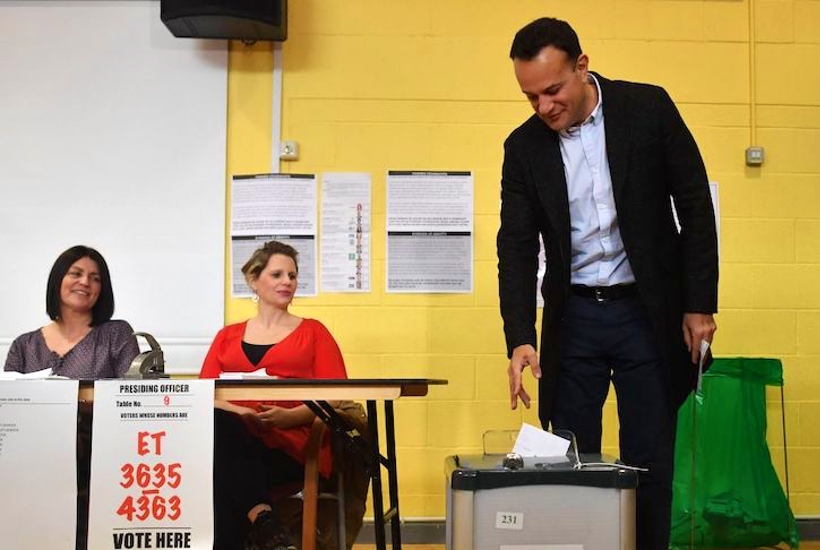You know the story. A Prime Minister takes a tough line on Brexit talks and holds a snap election thinking voters will be impressed – instead, they don’t care and it ends in disaster. It happened to Theresa May in 2017 and it just has happened to Leo Varadkar. The votes are still being counted, but it’s clear that no party has a majority, or anything close to a majority and that Varadkar’s gamble failed. Support for his Fine Gael has plunged and a stunning Sinn Fein surge has changed everything.
It’s not just that Sinn Fein won most of the first preference votes. For decades, Irish politics has been divided between Fine Gael and Fianna Fail. Now, the big two are a big three – which means none of them are near power. It’s new territory for Ireland. Varadkar has made history by becoming the first Taoiseach to be be denied first place in his own constituency, beaten by a Sinn Fein candidate. Under the Irish system, between three and five representatives are returned for each seat – so Varadkar is back in parliament. But as what? He is now talking being “part of” a new government but will only stay as party leader “if my party will have me.”
Irish voters just weren’t interested in Brexit. They were not wooed by Varadkar’s strong-and-stable economic record either. Most voters, he admitted to RTE radio, “took the view that the economy would look after itself and that the Brexit talks would look after itself.” And they were his two trump cards. Earlier on, I heard his Fine Gael colleague Neil Richmond grumble that this “was not the Brexit election that some had expected.” You can say that again. The exit poll (below) showed Brexit was the main issue for a princely 1 per cent of voters: health, housing and pensions were the top three concerns. So after all of that posturing, there was no Brexit dividend for Varadkar. The Irish voters have other, more serious issues on their mind.

Paschal Donohoe, Varadkar’s finance minister, has downplayed the idea that his often-austere budgets were to blame. He sees wider trends, an Irish election taht has more “similarities to European results than we have seen in other elections”. You can certainly see similarities to Britain’s last election. Political tribalism is on the wane, hence the mass defections from Team Varadkar to Sinn Fein.
There’s also a Corbynesque effect of young urban voters switching to Sinn Fein, not being put off by associations with an IRA that they can barely remember. Sinn Fein has served up Corbynesque policies: a three-year rent freeze, a pledge to build 100,000 houses, a tax credit offering a month’s rent cashback. For young parents, it promises to cut childcare costs by two-thirds. And to pay for it all a tax on (you guessed it) the rich and the banks. A new wealth tax, more inheritance tax etc.
Sinn Fein only fielded 42 candidates – so has no chance of winning the 80 seats needed for a majority. Its best bet, now, may see if Fine Gael and Fianna Fail – the two great rivals – will be daft enough to get together and form a ‘grand coalition.’ Then SF can sit back, be upgraded to the status of main opposition (like AfD in Germany) and wait for a government of losers to struggle on. It won’t last, and the odds are that SF would do even better in the next election. Strategic patience is, after all, the Sinn Fein speciality,
Micheal Martin, the Fianna Fail leader, also had the humiliation of finishing second to a Sinn Fein candidate in his Cork constituency. He seems to have worked out that it would be better to dip Sinn Fein’s hands in blood (so to speak) and get them into government. So he is quickly backtracking on what had been outright opposition to coalition with them.
But Mary Lou McDonald, Sinn Fein’s leader (who topped the poll in Dublin Central) looks unlikely to take the bait, saying that Ireland needs rid of both of these “conservative” parties and that she won’t enter coalition with either of them. (Sinn Fein, after all, is Gaelic for ‘ourselves alone’).
There is a sound to the Irish election. Silence, as the results of various candidates are read out – an embarrassed silence because every party other than the Greens have lost support. Then a huge roar as a Sinn Fein vote turns out to be far bigger than even SF supporters expected. Even in places like Tipperary, one of many supposedly SF-resistant places that have crumbled like Labour’s red wall.
Of course, this could be a bubble. The Sinn Fein surge happened the last few days of the campaign. It might go the same way as Irish Labour’s Gilmore gale ten years ago. Or something might have changed forever – and tonight, it does seem like that.
The century-old duumvirate of Fine Gael and Fianna Fail is no more. “It seems that we have now a three-party system,” Varadkar said earlier, which will “make forming a government quite difficult”. If it proves impossible then there might be another election, as in 1927. But for now, the shape of the next Irish government is anyone’s guess.
“It seems that we have now a three-party system … and that is going to make forming a government quite difficult,” says Fine Gael’s Leo Varadkar #GE2020 https://t.co/9z2Z0WWIa1 pic.twitter.com/DxPUzW7y2E— RTÉ News (@rtenews) February 9, 2020







Comments